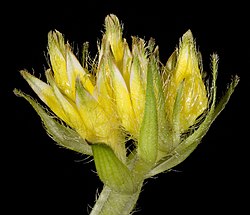Biology:Conostylis juncea
| Conostylis juncea | |
|---|---|

| |
| Scientific classification | |
| Kingdom: | Plantae |
| Clade: | Tracheophytes |
| Clade: | Angiosperms |
| Clade: | Monocots |
| Clade: | Commelinids |
| Order: | Commelinales |
| Family: | Haemodoraceae |
| Genus: | Conostylis |
| Species: | C. juncea
|
| Binomial name | |
| Conostylis juncea Endl.[1]
| |

| |
| Occurrence data from AVH | |
Conostylis juncea is a rhizomatous, tufted perennial, grass-like plant or herb in the family Haemodoraceae, and is endemic to the south-west of Western Australia. It has cylindrical or flat leaves and yellow flowers on a short flowering stem.
Description
Conostylis juncea is a rhizomatous, proliferous perennial with tufts up to 20 cm (7.9 in) in diameter. Its leaves are more or less round in cross-section or almost flat, 100–400 mm (3.9–15.7 in) long and 1–4 mm (0.039–0.157 in) wide and usually glabrous with prominent veins. The flowers borne just above the ground on a short flowering stalk with broadly egg-shaped or lance-shaped green bracts at the base. The perianth is hairy, yellow or greenish-yellow, 12–20 mm (0.47–0.79 in) long with lobes 9–12.5 mm (0.35–0.49 in) long. The anthers are 3.5–6 mm (0.14–0.24 in) long. Flowering occurs from July to September.[2][3][4]
Taxonomy and naming
Conostylis juncea was first formally described in 1839 by Stephan Endlicher in Novarum Stirpium Decades.[5][6] The specific epithet (juncea) means "rush-like".[7]
Distribution and habitat
This species of conostylis grows in sand in open woodland and heath in near-coastal areas between Jurien Bay and Australind in the Avon Wheatbelt, Geraldton Sandplains, Jarrah Forest and Swan Coastal Plain bioregions of south-western Western Australia.[2][3]
Conservation status
Conostylis juncea is listed as "not threatened" by the Western Australian Government Department of Biodiversity, Conservation and Attractions.[3]
References
- ↑ "Conostylis juncea". Australian Plant Census. https://biodiversity.org.au/nsl/services/apc-format/display/77489.
- ↑ 2.0 2.1 Hopper, S.D; Purdie, R.W; George, A.S; Patrick, S.J. "Conostylis juncea". Australian Biological Resources Study, Department of Agriculture, Water and the Environment. https://profiles.ala.org.au/opus/foa/profile/Conostylis%20juncea.
- ↑ 3.0 3.1 3.2 "Conostylis juncea". FloraBase. Western Australian Government Department of Parks and Wildlife. https://florabase.dpaw.wa.gov.au/browse/profile/1436.
- ↑ Green, John W. (1961). "The Genus Conostylis R.Br. II. Taxonomy.". Proceedings of the Linnean Society of New South Wales 85 (3): 356–357. https://www.biodiversitylibrary.org/item/108664#page/454/mode/1up. Retrieved 5 December 2023.
- ↑ "Conostylis juncea". APNI. https://biodiversity.org.au/nsl/services/rest/instance/apni/491598. Retrieved 5 December 2023.
- ↑ Endlicher, Stephan (1839). Novarum Stirpium Decades. 3. Vienna: K.K. Naturhistorisches Hofmuseum. pp. 19–20. https://www.biodiversitylibrary.org/item/221285#page/27/mode/1up. Retrieved 5 December 2023.
- ↑ Sharr, Francis Aubi; George, Alex (2019). Western Australian Plant Names and Their Meanings (3rd ed.). Kardinya, WA: Four Gables Press. p. 229. ISBN 9780958034180.
Wikidata ☰ Q15336353 entry
 |

